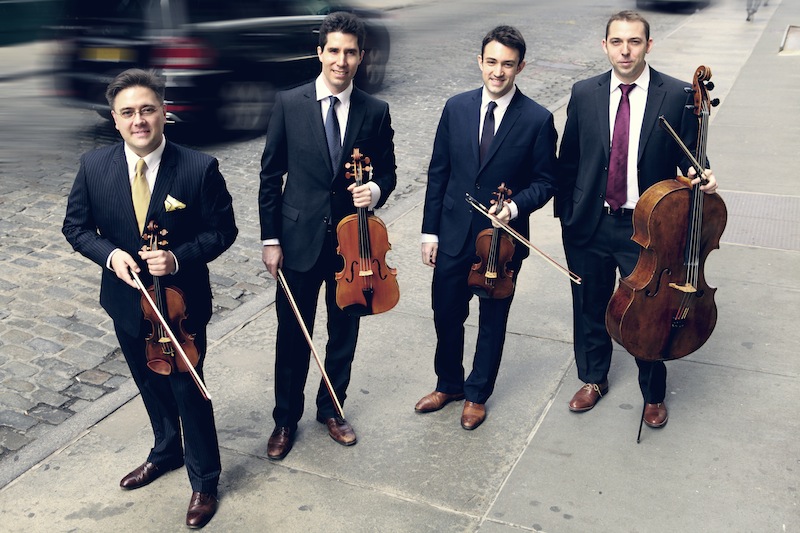Escher Quartet’s profound artistry makes powerful case for Zemlinsky

The Escher Quartet performed music of Alexander Zemlinsky Thursday night for the Chamber Music Society of Lincoln Center. Photo: Sophie Zhai
There is an ongoing fascination surrounding Alexander Zemlinsky. A well-known composer and teacher of the late romantic era, his musical and personal lives were deeply entwined with some of the most important musical figures of the day. He brought his scores to Brahms, loved Alma Schindler before she married Gustav Mahler, and taught Schoenberg (who married Zemlinsky’s sister Matilde). His constant association with greatness can leave the impression among those unfamiliar with his music that he himself was great, but neglected.
Zemlinsky was not among the top-rank composers, as exposure to his work consistently shows. The exceptions were his four string quartets, three of which offer some of the finest music in the genre from the early twentieth century. Thursday night in the Rose Studio, the Escher Quartet played the complete set of quartets, and their tremendous performance made Zemlinsky sound like a titan.
The concert was the first in a new series from the Chamber Music Society of Lincoln Center, “String Quartet Cycles in the Rose.” Each of the concerts will offer a complete quartet cycle, concentrating on less-often-performed composers like Nielsen, Ginastera, and Leon Kirchner. (The welcome exception will be the Jerusalem Quartet’s Bartók cycle in two concerts during twinter, 2016.)
The Escher Quartet has recorded definitive Zemlinsky performances (on two Naxos CDs) and proved well-matched with the music. Violinists Adam Barnett-Hart and Aaron Boyd, violist Pierre LaPointe, and cellist Brook Spelz played each piece like it was a masterpiece that demanded and deserved the deepest and most forceful commitment. This was true even for the solid but unexceptionable String Quartet No. 1.
In this First Quartet, Zemlinsky emulates Brahms, but with a sunnier and more extroverted attitude. It has an exacting formal design that is neat without being elegant. Everything falls into place in a lyrical, romantic style, but there are no surprises and, despite the tunefulness of the music, nothing memorable. The expression is limited by the composition’s traditional form.
Still, Escher played the music with a lovely, bright, slightly sweet sound. As an ensemble, they glow. In the remaining music, they added muscular intensity and the ability to change dynamics and moods in a split-second.
The following three quartets make music where the expression determines the form. Zemlinsky discovered himself as a composer in the nearly twenty-year gap between the First and Second Quartets. While his mature voice often comes out in unfocused structure and an emphasis on gestural effects, the quartets of this period are packed with ideas expressed in consistently inventive way. The music sounds like it is perpetually evolving, and is always fascinating and expressively rich.
In the last three quartets, Zemlinksy explores deep personal emotions, and his forms are flexible. He structures the music with such skill—inventive accompaniments, unexpected modulations, juxtapositions of mood and style—that everything is clear, every new event and direction logical. This way of finding, or creating, forms to fit the argument has much more in common with Debussy than with Schoenberg. Zemlinsky was never an atonal composer, and while his aesthetic was always romantic, he gleaned techniques and ideas from the neo-Classical music of Stravinsky and Hindemith.
Quartet No. 2 is full of hermetic, personal codes that refer to the personal rupture of Matilde’s affair with the painter Richard Gerstl. While the symbolism may have appealed to Zemlinsky’s circle, the finely etched expressionism of the music speaks for itself. Escher played the music powerfully, with a sense that they appreciated all the hidden meanings, enhancing the force of their own expression.
Strength of conviction was the foundation for all the ensemble’s playing, with the motivation that they were conveying profound art to the audience. As each piece grew more compositionally sophisticated and distinctive, so the playing grew in stature.
Through the Third and Fourth Quartets—the latter a haunting, complex meditation on Alban Berg’s death—Zemlinsky’s language becomes more allusive, but also reaches farther into internal experience and becomes more beautiful. Escher expressed each level of abstraction with proportionately more formal exactitude, beauty of sound, and thinking that was both plangent and agile.
This approached the Platonic idea of a concert, music played at the highest possible level and with the most profound and meaningful thinking. Through the artistry of the Escher Quartet, on this night Zemlinsky became one of the greats.
“String Quartets in the Rose” continues November 12 with the Danish String Quartet playing a complete Nielsen cycle. chambermusicsociety.org



Posted Oct 31, 2015 at 2:56 pm by Michael Comins
An intensely profound experience. We were thrilled!